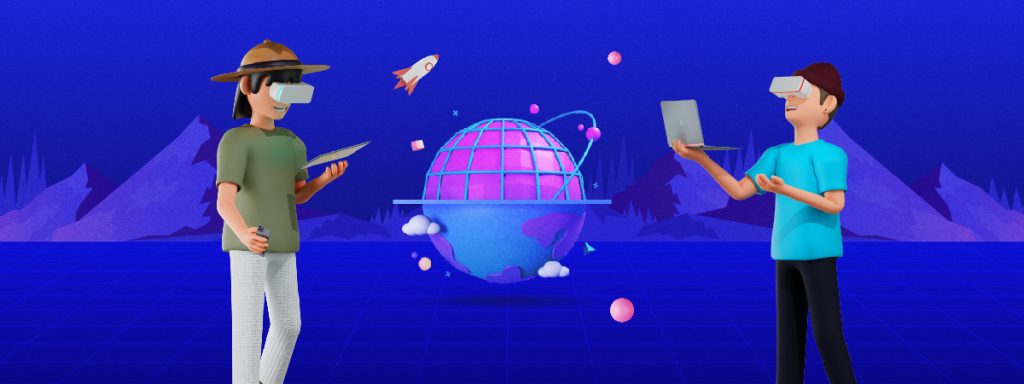Metaverse: A Virtual World of Infinite Possibilities
The metaverse is a virtual digital world where users can communicate with each other to engage in activities like socializing, gaming, and others. The metaverse has witnessed a rise in popularity as more and more users are getting involved every day. This rise in popularity has prompted big tech companies to invest and capture the new emerging tech market. NFTs, crypto tokens, and play-to-earn games have made the metaverse a place for new-generation users. Metaverse is also expected to be a social phenomenon with real-world features like gaming, 3D worlds, and socializing.
The success of the metaverse is due to the presence of certain vital technologies. These key technologies have been listed in the blog below.
What is Metaverse Technology, and Why is it Important?
Metaverse development is only possible due to technologies like AR, VR, 3D modelling, edge computing, blockchain, and artificial intelligence. The metaverse has plenty of possibilities for real-world applications. Many businesses have realized the potential of this technology. Many brands have bought virtual properties on the metaverse to create virtual showrooms. It will not be surprising if this technology transforms the way we use smartphones in the future.
Top 7 Technologies Used in the Metaverse
Many companies use innovative technologies like AR, VR, AI, 3D modelling, blockchain, and edge computing to make the metaverse experience more immersive.
1. Virtual reality (VR) and augmented reality (AR)
AR and VR empower and enable a few key features of the metaverse. Users can enter virtual worlds with the help of VR glasses. These glasses can be connected to other smart devices, tablets, and smartphones.
Users can explore the metaverse to visit virtual businesses, chat with friends, play games to earn money, and more. AR creates a fusion between real-world environments and virtual objects with the help of a device’s camera. AR and VR have unlimited possibilities in gaming, learning, and other sectors.
Read more: Play to Earn vs Move to Earn
2. Blockchain and crypto
Blockchain technology is a decentralized solution for the transfer of value, accessibility, proof of ownership, governance, and interoperability. Crypto tokens enable users to transfer value while they work and play in the metaverse. For example, users can buy virtual lands in Decentraland using crypto tokens. Users can also purchase land parcels in the form of NFTs. The ownership of these virtual lands can be secured using blockchain technology.
Crypto can incentivize users to work in the metaverse. We will see many metaverse jobs in the future, as many companies prefer remote working.
Read more: Blockchain vs Crypto
3. Artificial intelligence (AI) and machine learning (ML)
AI has the potential to become a vital part of our daily lives. From Alexa to Chat GPT, we already use AI to perform many daily tasks. Metaverse can tremendously improve its performance by integrating with AI.
AI can help the metaverse in many processes, from faster computations to business strategy planning. AI can also process data at a superfast speed with the help of machine learning techniques. Historical data can be used to create unique insights and outputs in the metaverse.
4. Edge computing
Fast data transmission is a requirement of the metaverse. Edge computing helps to enable faster data transmission in businesses worldwide. A newer version of edge computing known as distributed computing allows users to enjoy edge computing without setting up hardware infrastructures. Edge computing will play a major role in delivering features to Metaverse users.
Read more: What is Metaverse
5. 5G and Next-Generation Connectivity
Another vital feature is the availability of 5G networks. Users often face issues with their crypto network when engaging with the metaverse due to slow data transfer speeds and rendering. Users can experience the metaverse from their laptops or other devices due to the availability of 5G network services at affordable rates. Fast network connectivity eliminates issues like lag in the crypto network.
6. 3D modelling and simulation
3D modelling captures the appearance of real-world objects and makes them a reality in the metaverse. This technology provides a three-dimensional framework for a specific product or process. According to SkyQuest Technology, the 3D technology market is expected to double over the next few years, reaching almost $2 billion in 2028.
7. Haptic feedback and biometric sensors
The use of touch to communicate is known as haptic feedback. It is a new way for humans and machines to communicate. Haptic technology has come a long way since the first robot hand. Haptics are playing a vital role in VR and real-time interactions. More research has to be done on haptic and biometric technology to fully realize its potential.
Haptics technology enables the use of force feedback. This technology can have significant applications, from DeFi applications to gaming. More sophisticated interfaces will emerge as haptic, biometric, and edge computing technologies are further refined.
Key Challenges and Opportunities in Metaverse Development

The metaverse is still in its nascent stage, and some issues need to be addressed for its successful adoption.
- With the increase in crypto scams and malicious software, security is one of the primary issues in the metaverse. The metaverse will need to improve its security standards to give users confidence that their assets are secure and that they can safely engage with the metaverse.
- Privacy is the other major issue in the metaverse. Users are susceptible to having their identities compromised as they use devices such as AR, VR, and webcams. Criminals have hacked these devices to spy on users. The metaverse should address privacy concerns and find solutions to these issues.
Conclusion
Our future looks to be all digital. The metaverse is still under development, but many businesses are already using it and offering products and services to users. The metaverse uses many vital technologies to provide users with an immersive experience. The Sandbox and Decentraland are notable metaverse crypto projects, but big tech companies are investing heavily in this technology. There will be more exciting features in the metaverse as these technologies advance.
Read more: Decentraland Vs Sandbox
You can read more about crypto on ZebPay blogs. Visit ZebPay and begin trading with more than 100 unique cryptos.







